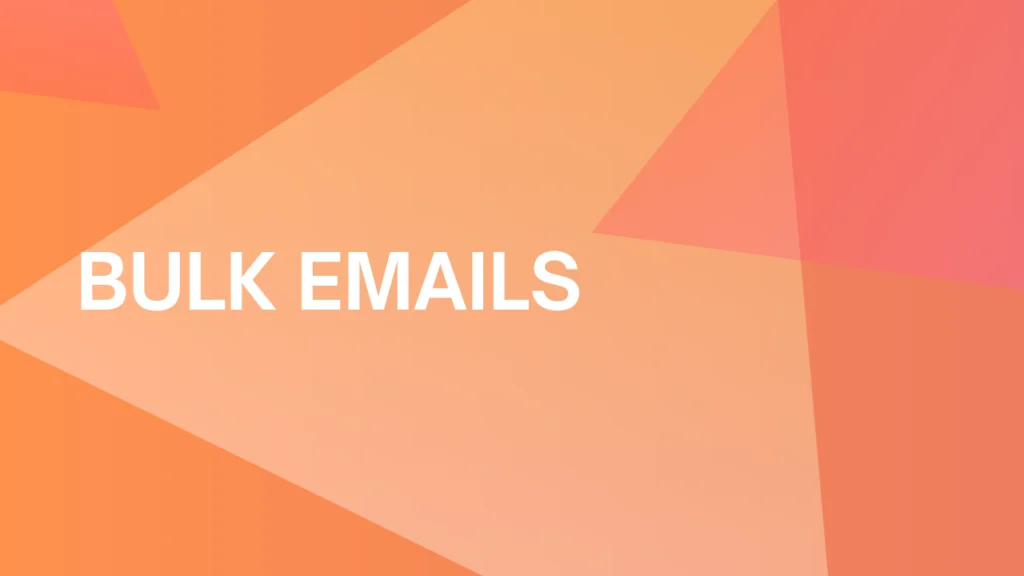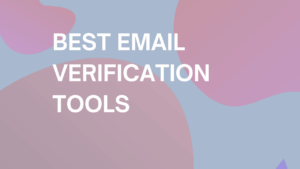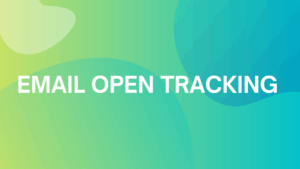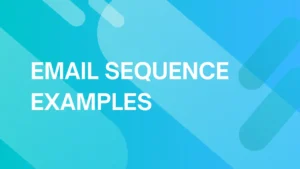
Unlocking the Potentials of Bulk Emails: Best Practices and Common Pitfalls
Bulk emails have become a valuable component in the toolbox of marketers and businesses, reaching large numbers of customers at once.
The emails can take various forms, each serving a unique role in a company’s marketing strategy.
While businesses large and small use bulk email campaigns in varied ways, the end goal is always the same – to drive interaction and increase customer awareness.
Feeling unsure about whether bulk email is for you? Consider these statistics and decide for yourself!
- At the time of writing, email marketing revenue sits at $10.89 billion.
- Marketing emails have an open rate of 18% worldwide
- 82% of marketers globally use email marketing
What is Bulk Email?
Bulk email refers to the practice of sending a single email to numerous recipients all at once. incorporating this approach can deliver a host of benefits, provided it’s managed effectively. When done right, bulk emailing benefits can take you far.
- Drive brand recognition and foster loyalty among your subscribers
- Generate new leads and spur sales
- Facilitate widespread information sharing quickly and efficiently
However, using bulk email also comes with its fair share of challenges.
- Creating engaging content that will capture the recipient’s attention
- Keeping a good sending reputation to avoid your emails ending up in the spam folder
- Maintaining a clean, updated email list for better deliverability
Given these challenges, a meticulously managed bulk email strategy is crucial. This strategy will allow you to fully reap the rewards of bulk emailing while minimizing potential obstacles.
With the right approach and tools, you can turn these challenges into opportunities for your brand’s growth.
Types of Bulk Emails
There are several different types of bulk email campaigns, each serving a specific purpose in a company’s email marketing strategy.
a) Newsletters
With 81% of B2B marketers stating that newsletters are their most-used bulk email strategy, this tried and true method is hard to ignore!
Newsletters are regular updates or communications sent to subscribers, providing them with the latest news about your company, products, or industry.
Benefits of newsletters include:
- Keeping your brand top-of-mind for customers
- Educating subscribers about your products, services, or industry trends
- Building and maintaining strong relationships with your audience
b) Promotional Emails
Unless you’ve been living off the grid, you’ve definitely seen these types of emails floating around your inbox for decades. Promotional emails are used to inform customers about special offers, discounts, or new product launches.
Some benefits of promotion emails can include:
- Driving immediate action, such as purchases or site visits
- Increasing customer engagement by providing value in the form of discounts or special offers
- Announcing new products or services to stimulate interest and sales
c) Acquisition Emails
Acquisition emails are a key component of sales prospecting techniques, designed to convert prospects into customers.
What is sales prospecting? It’s the process of identifying potential customers and engaging them with the goal of converting them into clients.
These emails often offer deals or incentives to encourage purchases, directly targeting new leads to enhance brand awareness and sales.
Acquisition emails tend to be more targeted, and can be a key player in increasing brand awareness.
Benefits of acquisition emails:
- Attracting new customers to grow your business
- Offering incentives that could lead to immediate sales
- Moving leads down the sales funnel, bringing them closer to conversion
d) Retention Emails
Retention emails are aimed at maintaining customer loyalty and encouraging repeat business.
Have you ever let a subscription expire or stopped using a service? Chances are you got a retention email, asking you to continue subscribing or buying.
The benefits of retention emails:
- Keeping existing customers, which is more cost-effective than acquiring new ones
- Encouraging repeat purchases, leading to increased lifetime customer value
- Building strong, long-term relationships with your audience through consistent engagement.
Best Practices for Effective Bulk Email Campaigns
The potency of a bulk email campaign can be substantially amplified by diligently following a set of best practices.
These methodologies not only expand your potential reach but also foster enduring and meaningful engagement with your audience over time.
New Google Rules For Bulk Email Senders
As always, Google strives towards being as perfect as possible, which means a lot of updates on rules and best practices.
On that note, the fine folks at Google have recently laid out some new rules that all bulk email senders must adhere to.
These rules aim to improve the user experience and serve to protect email recipients from unwanted spam. But don’t worry! Here’s the skinny on the new regulations, and how to comply.
| Want to hear it from the horse’s mouth? Check out Google’s official 2024 rules announcement. |
1. Authenticate Your Email
Google will be placing a heavy emphasis on email authentication to combat phishing and spam.
Emails that fail to authenticate are more likely to be flagged as spam or not delivered at all.
To get ahead of this and keep your emails where they belong, begin by implementing industry-standard authentication protocols like SPF, DKIM, and DMARC.
Following these protocols will keep your emails authenticated and free from any unwanted attention from Google’s spam bots.
2. Enable Easy Unsubscription
If you haven’t already, you’ll need to include a simple, one-click unsubscription feature in your emails. Moreover, any unsubscription request must be processed within two days.
To comply with this rule, just add an “Unsubscribe” button or link in a visible spot within your email template.
You also need to make sure that clicking this button immediately removes the user from your mailing list, or initiates a process that will do so within 48 hours.
3. Send Wanted Email
Google will enforce a clear spam rate threshold (not yet announced) for all bulk senders.
Exceeding this rate may result in your emails being marked as spam, which will significantly impact your deliverability.
How to tackle this? Closely monitor your engagement metrics.
Maintain a clean email list by removing inactive or unresponsive subscribers, and focus on providing valuable content that your audience wants to read.
When you make these changes before 2024, you’re not just complying with Google’s latest rules, you’re also elevating the effectiveness and credibility of your email campaigns.
4. Learn how to send an email to multiple recipients individually
Understanding how to send an email to multiple recipients individually can help maintain personalization and reduce the chances of your emails being marked as spam.
This practice ensures that each recipient feels valued and reduces the likelihood of triggering spam filters.
The future of email is set to be more secure, more user-friendly, and less cluttered. It’s time to adapt and make these best practices an integral part of your email marketing strategy!
The future of email is set to be more secure, more user-friendly, and less cluttered. It’s time to adapt and make these best practices an integral part of your email marketing strategy!
Initiating Your Campaign
The start of any successful bulk email campaign begins with three fundamental steps:
a) Understanding Your Audience: The first step to launching an effective bulk email campaign is to gain an in-depth understanding of your target audience.
To do this, gather information about your audience’s demographics, interests, online behaviors, and pain points. You can use this data to tailor your content to meet their needs, ultimately leading to higher engagement.
b) Setting Realistic Expectations: Set clear, achievable goals for your campaign. Are you trying to drive traffic to your website, increase product sales, or foster customer loyalty?
By establishing tangible objectives, you can measure the success of your campaign and make adjustments as necessary. SMART goals are a great set of guidelines to making realistic expectations.
c) Emphasizing Quality Content: The content of your emails should be valuable, relevant, and engaging. It should resonate with your audience and encourage them to interact with your emails.
High-quality content can significantly increase open rates and conversions, and reduce unsubscribe rates.
| Want to learn about how to start an email campaign? Check out our post about email campaign ramp-up! |
Incrementally Increasing Your Sending Volume
Proper management of your sending volume can significantly improve your email deliverability rates. Here’s how:
- Start Small – Don’t rush to send out a large volume of emails all at once! Begin your campaign by sending to a smaller, segmented list of subscribers. This approach allows you to test the waters, adjust your strategy based on initial responses, and maintain a favorable reputation with ISPs.
- Increase in Increments – Gradually scale up your sending volume over time. This strategy, known as IP warming, helps ISPs recognize your IP as a legitimate email sender, reducing the likelihood of your emails being marked as spam.
- Monitor Your Performance – Keep a close eye on key metrics such as open rates, click-through rates, bounce rates, and unsubscribe rates. These metrics can provide valuable insights into the effectiveness of your campaign and inform any necessary adjustments to your strategy.
Upholding the Health of Your Email List
An optimized email list is pivotal to the success of your campaign. Here’s how to maintain it:
- Regularly Clean Your Email List: Prune inactive or non-responsive email addresses from your list regularly. This practice improves your engagement metrics and sender reputation, leading to higher email deliverability.
- Utilize Double Opt-In: A double opt-in process ensures that your subscribers genuinely want to receive your emails, thus reducing the likelihood of spam complaints and enhancing engagement rates.
- Manage Bounces and Complaints: Take immediate action to address hard bounces and spam complaints. These issues, if left unattended, can harm your sender reputation and negatively impact your deliverability rates.
Implementing Proper Email Authentication Protocols
Securing correct authentication for your emails can greatly boost the probability of your communications arriving directly in your subscribers’ inboxes.
- Apply SPF, DKIM, and DMARC: These email authentication protocols verify that your emails originate from a trusted source, reducing the likelihood of them being marked as spam or phishing attempts.
- Use Dedicated IP Addresses: A dedicated IP address provides you full control over your sender reputation. Unlike shared IP addresses, a dedicated IP ensures that your reputation is not affected by the actions of others.
- Regularly Review Your Sending Reputation: Monitor your sender reputation score frequently using online tools. A good reputation score can improve your email deliverability rates and ensure that your emails reach your subscribers’ inboxes.
Common Mistakes and Challenges in Bulk Email Campaigns
The path to successful bulk email campaigns is often fraught with potential pitfalls and challenges.
Awareness and proactive management of these common issues can definitely improve the effectiveness of your campaigns.
Let’s explore some of these challenges!
1. Lack of Segmentation
Many marketers make the mistake of sending the same email to every subscriber.
This can lead to low engagement rates because the content may not be relevant to everyone.
Segmentation, which involves dividing your email list into different categories based on factors like customer behavior or interests, allows you to send more targeted and personalized emails.
Email scraping tools can assist in gathering segmented data, but verifying and cleaning this data is essential to avoid issues.
2. Sending Emails at the Wrong Time
Timing is critical in email marketing. If you send your emails when your subscribers are most likely to be busy or asleep, they could get buried under other emails.
It’s important to test and identify the best times to send your emails for maximum visibility and engagement.
3. Ignoring Mobile Users
With the increasing use of mobile devices and 56% of email marketers incorporating cell phone compatible strategies, it’s a mistake to ignore mobile-friendly design.
When your emails are not optimized for mobile, they may not display correctly on a smaller screen, leading to a poor user experience and possibly even unsubscribes.
4. Neglecting to Test Emails
Sending emails without testing them first can lead to formatting errors, broken links, or even spam filter issues.
It’s crucial to test your emails thoroughly before sending them to ensure everything looks and works as intended.
Invaluable Tools and Software for Bulk Email Campaigns
Mastering bulk email campaigns requires the right mix of strategy and technology.
Thankfully, various tools and software can help automate, manage, and optimize your bulk email efforts, from crafting engaging emails to ensuring high deliverability.
Here are some top tools every marketer should consider:
Warmup Inbox
Warmup Inbox helps your bulk emails have the best chance of being delivered and opened by warming up your IP address and inbox before you start ramping up your campaigns.
- IP Warming: Warmup Inbox helps in warming up your IP address and domain to build your reputation with Internet Service Providers (ISPs), significantly improving your email deliverability.
- Analytics: Warmup Inbox also provides detailed analytics, giving you insights into your campaign performance.
Sign up for a 7 day free trial!
EmailListVerify
For keeping a clean email list and staying out of the spam folder, consider EmailListVerify.
When used in tandem with WarmupInbox, your deliverability rates will soar!
- Email List Cleaning: This tool ensures your email lists are free from invalid addresses, hard bounces, and spam traps that can damage your sender reputation.
- Easy Integration: EmailListVerify can easily integrate with other email marketing software, allowing for seamless list validation.
Want to have a sparkly fresh email list? Verify 100 emails for free!
SendGrid
- Versatility: SendGrid is ideal for sending both transactional and marketing emails in bulk.
- Email Authentication: Supports SPF, DKIM, and DMARC authentication protocols to help increase your email deliverability.
- API Integration: SendGrid provides an API that developers can integrate into their applications for seamless email management.
ConvertKit
- Audience Segmentation: ConvertKit allows you to easily segment and tag your subscribers, enabling you to send highly targeted emails.
- Visual Automation Builder: Its visual automation builder helps in creating customized email funnels.
- Comprehensive Analytics: The tool offers analytics to give you clear insights into your campaign’s performance.
These tools, each with its unique strengths, can significantly boost your bulk email campaigns.
Remember to understand your specific needs and goals to make the right choice!
Final Thoughts
Executing a successful bulk email campaign involves a complex balance of strategic planning, content creation, and technical management.
The strategies and best practices discussed in this article, if applied diligently and consistently, can significantly improve your campaigns’ effectiveness and your overall email marketing results.
Whether you’re sending out newsletters to keep customers in the loop, acquisition emails to bring in new leads, promotional emails to drive sales, or retention emails to foster loyalty, bulk email can be a highly effective tool in your marketing arsenal.
One cannot overstate the role that tools like WarmupInbox play in optimizing your bulk email campaigns.
From warming up your IP address to providing insightful analytics, Warmup Inbox assists in ensuring your emails reach the intended recipient, maximizing your open and click-through rates.
A good email marketing tool is an investment, not an expense!



